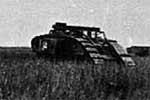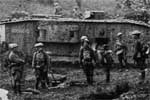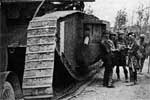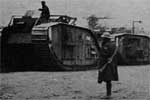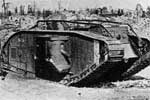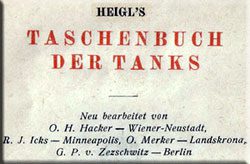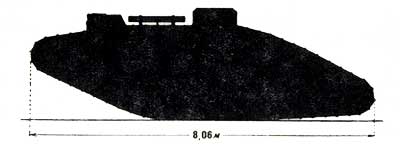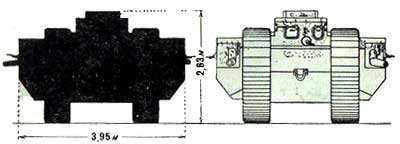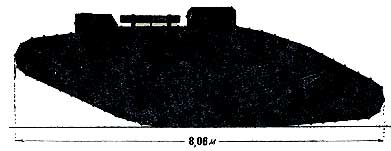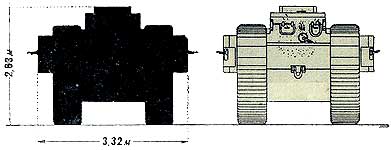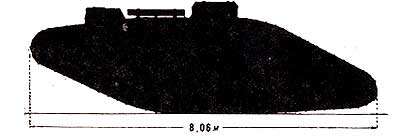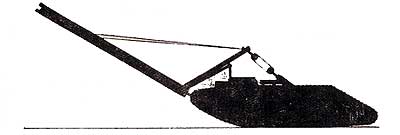
Heavy tanks Mk V and Mk V * (with a star)
Heavy tanks Mk V and Mk V * (with a star)
Another important difference was the commander's cupola and special folding plates in the aft area, with the help of which it was possible to transmit conditional signals (the plates had several positions, each of which carried specific information). Prior to this, tank crews on the battlefield were completely isolated from the outside world. They not only did not have a means of communication, but the visual overview was limited by narrow viewing slots. Voice messaging was also impossible due to the loud noise generated by the engine running. In the first tanks, the crews often resorted to the help of carrier pigeons to deliver emergency messages to the rear. The main armament of the artillery tank consisted of two 57-mm cannons, in addition, four Hotchkiss machine guns were installed. The thickness of the armor varied from 6 to 12 mm. By the time the armistice was concluded, about 400 Mk V tanks had been built at the Birmingham plant. The vehicles were produced in various modifications. Thus, the Mk V * tank had a hull lengthened by 1,83 m, which increased its ability to overcome ditches, and also made it possible to place troops of up to 25 people inside or transport a significant amount of cargo. The Mk V** was produced in both artillery and machine gun versions.
After the arrival of American troops in Europe, the tanks entered service with the first tank battalion of the US Armed Forces and, thus, became the first American tanks. However, the French FT 17s also entered service with this battalion. After the war, the Mk V tanks remained in service, on their base were created bridgelayers and sapper tanks, but in 1918 their production was discontinued. A number of Mk V tanks were transferred to the Canadian army, where they remained in service until the early 1930s. From the middle of 1918, Mk V tanks began to enter the British troops in France, but they did not justify the hopes placed on them (an offensive with massive use of tanks was planned for 1919) - the war ended. In connection with the ceasefire agreement reached, the production of tanks was stopped, and the modifications already developed (BREM, advanced support vehicle) remained in the drawings. In the development of tanks, a relative stagnation began, which will be broken after the whole world in 1939 learns what a “blitzkrieg” is.
From the 1935 Heigl handbookPerformance charts and illustrations from the same source.
Heavy tanksAlthough the development of heavy tanks got its start in England, however, in this country, apparently, they finally abandoned the adoption of a heavy tank. It was from England at the disarmament conference that the proposal came to declare heavy tanks offensive weapons and, as such, to ban them. Apparently, due to the high cost of developing heavy tanks, the Vickers company does not go for their new designs, even for export to the foreign market. The new 16-ton medium tank is regarded as a sufficiently powerful combat vehicle capable of becoming the backbone of modern mechanized formations.
TTC tank Mk V
TTC tank Mk V The heavy tanks of the World War era reflect the requirements of high flotation through ditches, the ability to climb over vertical obstacles and the destructive effect of their own weight. These demands were the result of the positional nature of the western front, pitted with craters and fortifications. Starting with overcoming the "lunar landscape" with armored machine guns (the first tank unit was called the "heavy platoon of the Heavy Machine Gun Corps"), they soon moved on to installing one or more guns in the sponsons of heavy tanks adapted for this purpose.
Gradually, the requirements of a circular view for the tank commander appear. They began to be carried out first in the form of small armed fixed turrets above the roof of the tank, as, for example, on the VIII tank, where there were over 4 machine guns in such a turret. Finally, in 1925, the former forms were finally abandoned, and the Vickers heavy tank was built according to the experience of medium tanks with weapons mounted in turrets with circular rotation.
If the old heavy tanks of brands I-VIII mechanically reflected the positional nature of warfare, then the design of the Vickers heavy tank, reminiscent of naval warships, gives a clear idea of the development of the modern “land armored fleet”. This tank is a dreadnought of armored parts, the necessity and combat value (of which, in comparison with small agile and cheap light tanks, is also debatable, as is the case with battleships compared with destroyers, submarines and seaplanes in the navy.
TTX tank Mk V * (with a star)
TTX tank Mk V * (with a star)
| |||||||||||||||||||||||||||||||||||||||||||||||||||

 The Mk V tank was the last mass-produced tank to feature the characteristic slanted outline and was the first to use an improved gearbox. Thanks to this innovation, the power plant could now be controlled by one crew member, and not two, as before. A specially designed Ricardo engine was installed in the tank, which not only developed high power (112 kW, 150 hp), but was also quite reliable.
The Mk V tank was the last mass-produced tank to feature the characteristic slanted outline and was the first to use an improved gearbox. Thanks to this innovation, the power plant could now be controlled by one crew member, and not two, as before. A specially designed Ricardo engine was installed in the tank, which not only developed high power (112 kW, 150 hp), but was also quite reliable.

